Recent Progress in Fabrications and Applications of Heating-Induced Long Period Fiber Gratings
Abstract
:1. Introduction
2. Fabrications
2.1. CO2 Laser Heating Techniques
2.1.1. LPFGs in Conventional Fiber
2.1.2. LPFGs in PCF
2.1.3. LPFGs in PBF
2.2. Hydrogen–Oxygen Flame Heating Techniques
2.2.1. LPFGs in Conventional Glass Fiber
2.2.2. LPFGs in PCF
2.3. Arc Discharge Heating Techniques
3. OAM Mode Converters
3.1. OAM Mode Converters Based on SLPFGs
3.2. OAM Mode Converters Based on HLPFGs
4. Strain Sensors
5. Pressure Sensors
6. Torsion Sensors
7. Biochemical Sensors
8. Conclusions
Author Contributions
Funding
Conflicts of Interest
References
- Hill, K.; Fujii, Y.; Johnson, D. Photosensitivity in optical fiber waveguides-application to reflection filter fabrication. Appl. Phys. Lett. 1978, 32, 647–649. [Google Scholar] [CrossRef]
- Rao, Y. In-fibre Bragg grating sensors. Meas. Sci. Technol. 1997, 8, 355–375. [Google Scholar] [CrossRef]
- Rao, Y. Recent progress in applications of in-fibre Bragg grating sensors. Opt. Lasers Eng. 1999, 31, 297–324. [Google Scholar] [CrossRef]
- Gagne, M.; Loranger, S.; Lapointe, J.; Kashyap, R. Fabrication of high quality, ultra-long fiber Bragg gratings: Up to 2 million periods in phase. Opt. Express 2014, 22, 387–398. [Google Scholar] [CrossRef]
- Bhatia, V.; Vengsarkar, A. Optical fiber long-period grating sensors. Opt. Lett. 1996, 21, 692–694. [Google Scholar] [CrossRef]
- Davis, D.; Gaylord, T.; Glytsis, E.; Kosinski, S.; Mettler, S.; Vengsarkar, A. Long-period fibre grating fabrication with focused CO2 laser pulses. Electron. Lett. 1998, 34, 302–303. [Google Scholar] [CrossRef]
- Davis, D.; Gaylord, T.; Glytsis, E.; Mettler, S. CO2 laser-induced long-period fibre gratings: Spectral characteristics, cladding modes and polarisation independence. Electron. Lett. 1998, 34, 1416–1417. [Google Scholar] [CrossRef]
- Vengsarkar, A.; Lemaire, P.; Judkins, J.; Bhatia, V.; Erdogan, T.; Sipe, J. Long-period fiber gratings as band-rejection filters. J. Lightware Technol. 1996, 14, 58–65. [Google Scholar] [CrossRef]
- Kopp, V.; Churikov, V.; Singer, J.; Chao, N.; Neugroschl, D.; Genack, A. Chiral fiber gratings. Science 2004, 305, 74–75. [Google Scholar] [CrossRef]
- Oh, S.; Lee, K.; Paek, U.; Chung, Y. Fabrication of helical long-period fiber gratings by use of a CO2 laser. Opt. Lett. 2004, 29, 1464–1466. [Google Scholar] [CrossRef]
- Wang, P.; Li, H. Helical long-period grating formed in a thinned fiber and its application to a refractometric sensor. Appl. Opt. 2016, 55, 1430–1434. [Google Scholar] [CrossRef] [PubMed]
- Kong, X.; Ren, K.; Ren, L.; Liang, J.; Ju, H. Chiral long-period gratings: Fabrication, highly sensitive torsion sensing, and tunable single-band filtering. Appl. Opt. 2017, 56, 4702–4707. [Google Scholar] [CrossRef] [PubMed]
- Fu, C.; Liu, S.; Bai, Z.; He, J.; Liao, C.; Wang, Y.; Li, Z.; Zhang, Y.; Yang, K.; Yu, B.; et al. Orbital angular momentum mode converter based on helical long period fiber Grating Inscribed by Hydrogen-Oxygen Flame. J. Lightware Technol. 2018, 36, 1683–1688. [Google Scholar] [CrossRef]
- Fu, C.; Liu, S.; Wang, Y.; Bai, Z.; He, J.; Liao, C.; Zhang, Y.; Zhang, F. High-order orbital angular momentum mode generator based on twisted photonic crystal fiber. Opt. Lett. 2018, 43, 1786–1789. [Google Scholar] [CrossRef] [PubMed] [Green Version]
- Fu, C.; Wang, Y.; Bai, Z.; Liu, S. Twist-direction-dependent orbital angular momentum generator based on inflation-assisted helical photonic crystal fiber. Opt. Lett. 2019, 44, 459–462. [Google Scholar] [CrossRef] [PubMed]
- Fu, C.; Wang, Y.; Liu, S.; Bai, Z.; Tang, J.; Shao, L.; Liu, X. Transverse-load, strain, temperature, and torsion sensors based on a helical photonic crystal fiber. Opt. Lett. 2019, 44, 1984–1987. [Google Scholar] [CrossRef]
- Zhang, Y.; Bai, Z.; Fu, C.; Liu, S.; Tang, J.; Yu, J.; Liao, C.; Wang, Y.; He, J. Polarization-independent orbital angular momentum generator based on a chiral fiber grating. Opt. Lett. 2019, 44, 61–64. [Google Scholar] [CrossRef]
- Wong, G.; Kang, M.; Lee, H.; Biancalana, F.; Conti, C.; Weiss, T. Excitation of orbital angular momentum resonances in helically twisted photonic crystal fiber. Science 2012, 337, 446–449. [Google Scholar] [CrossRef]
- Xi, X.; Wong, G.; Thomas, W.; Russell, P. Measuring mechanical strain and twist using helical photonic crystal fiber. Opt. Lett. 2013, 38, 5401. [Google Scholar] [CrossRef]
- Xi, X.; Wong, G.; Frosz, M.; Babic, F.; Ahmed, G.; Jiang, X. Orbital-angular-momentum-preserving helical Bloch modes in twisted photonic crystal fiber. Optica 2014, 1, 165–169. [Google Scholar] [CrossRef]
- Xi, X.; Weiss, T.; Wong, G.; Biancalana, F.; Barnett, S.; Padgett, M.; Russell, P. Optical activity in twisted solid-core photonic crystal fibers. Phys. Rev. Lett. 2013, 110, 143903. [Google Scholar] [CrossRef] [PubMed]
- Li, Z.; Liu, S.; Bai, Z.; Fu, C.; Zhang, Y.; Sun, Z.; Liu, X.; Wang, Y. Residual-stress-induced helical long period fiber gratings for sensing applications. Opt. Express 2018, 26, 24113–24122. [Google Scholar] [CrossRef] [PubMed]
- Rao, Y.; Wang, Y.; Ran, Z.; Zhu, T. Novel fiber-optic sensors based on long-period fiber gratings written by high-frequency CO2 laser pulses. J. Lightwave Technol. 2003, 21, 1320–1327. [Google Scholar]
- Rao, Y.; Zhu, T.; Ran, Z.; Wang, Y.; Jiang, J.; Hu, A. Novel long-period fiber gratings written by high-frequency CO2 laser pulses and applications in optical fiber communication. Opt. Commun. 2004, 229, 209–221. [Google Scholar] [CrossRef]
- Wang, Y.; Wang, D.; Jin, W.; Rao, Y.; Peng, G. Asymmetric long period fiber gratings fabricated by use of CO2 laser to carve periodic grooves on the optical fiber. Appl. Phys. Lett. 2006, 89, 151105. [Google Scholar] [CrossRef]
- Tian, F.; Kanka, J.; Zou, B.; Chiang, K.; Du, H. Long-period gratings inscribed in photonic crystal fiber by symmetric CO2 laser irradiation. Opt. Express 2013, 21, 13208–13218. [Google Scholar] [CrossRef]
- Wang, Y.; Jin, W.; Ju, J.; Xuan, H.; Ho, H.; Xiao, L.; Wang, D. Long period gratings in air-core photonic bandgap fibers. Opt. Express 2008, 16, 2784–2790. [Google Scholar] [CrossRef] [Green Version]
- Zhong, X.; Wang, Y.; Liao, C.; Yin, G.; Zhou, J.; Wang, G.; Sun, B. Long period fiber gratings inscribed with an improved two-dimensional scanning technique. IEEE Photon. J. 2014, 6, 1–8. [Google Scholar] [CrossRef]
- Zhong, X.; Wang, Y.; Liao, C.; Liu, S.; Tang, J. Temperature-insensitivity gas pressure sensor based on inflated long period fiber grating inscribed in photonic crystal fiber. Opt. Lett. 2015, 40, 1791–1794. [Google Scholar] [CrossRef]
- Tang, J.; Yin, G.; Liu, S.; Zhong, X.; Liao, C.; Li, Z. Gas pressure sensor based on CO2-laser-induced long-period fiber grating in air-core photonic bandgap fiber. IEEE Photon. J. 2015, 7, 1–7. [Google Scholar]
- Tang, J.; Zhang, Z.; Yin, G.; Liu, S.; Bai, Z.; Li, Z.; Deng, M. Long period fiber grating inscribed in hollow-core photonic bandgap fiber for gas pressure sensing. IEEE Photon. J. 2017, 9, 1–7. [Google Scholar] [CrossRef]
- Fu, C.; Zhong, X.; Liao, C.; Wang, Y.; Wang, Y.; Tang, J.; Liu, S. Thin-core-fiber-based long-period fiber grating for high-sensitivity refractive index measurement. IEEE Photon. J. 2015, 7, 1–8. [Google Scholar] [CrossRef]
- Humbert, G.; Malki, A.; Fevrier, S.; Roy, P. Electric arc-induced long-period gratings in Ge-free air-silica microstructure fibres. Electron. Lett. 2003, 39, 349–350. [Google Scholar] [CrossRef]
- Rego, G.; Santos, J.; Salgado, H. Polarization dependent loss of arc-induced long-period fibre gratings. Opt. Commun. 2006, 262, 152–156. [Google Scholar] [CrossRef]
- Yin, G.; Wang, Y.; Liao, C.; Zhou, J.; Zhong, X.; Wang, G.; Sun, B.; He, J. Long period fiber gratings inscribed by periodically tapering a fiber. IEEE Photon. Technol. Lett. 2014, 26, 698–701. [Google Scholar] [CrossRef]
- Yin, G.; Tang, J.; Liao, C.; Wang, Y. Automatic arc discharge technology for inscribing long period fiber gratings. Appl. Opt. 2016, 55, 3873–3878. [Google Scholar] [CrossRef]
- Sun, B.; Wei, W.; Liao, C.; Zhang, L. Automatic arc discharge-induced helical long period fiber gratings and its sensing applications. IEEE Photon. Technol. Lett. 2017, 29, 873–876. [Google Scholar] [CrossRef]
- Li, J.; Fan, P.; Sun, L.; Wu, C.; Guan, B. Few-period helically twisted all-solid photonic bandgap fibers. Opt. Lett. 2018, 43, 655–658. [Google Scholar] [CrossRef]
- Kondo, Y.; Nouchi, K.; Mitsuyu, T.; Watanabe, M. Fabrication of long-period fiber gratings by focused irradiation of infrared femtosecond laser pulses. Opt. Lett. 1999, 24, 646–648. [Google Scholar] [CrossRef]
- Tang, J.; Fu, C.; Bai, Z.; Liao, C.; Wang, Y. Sensing characteristics of tilted long period fiber gratings inscribed by infrared femtosecond laser. Sensors 2018, 18, 3003. [Google Scholar] [CrossRef]
- Zhou, X.; Shi, S.; Zhang, Z.; Zou, J.; Liu, Y. Mechanically-induced pi-shifted long-period fiber gratings. Opt. Express 2011, 19, 6253–6259. [Google Scholar] [CrossRef] [PubMed]
- Nair, A.; Kumar, V.; Joe, H. Widely tunable LP11 cladding-mode resonance in a twisted mechanically induced long-period fiber grating. Appl. Opt. 2015, 54, 2007–2010. [Google Scholar] [CrossRef] [PubMed]
- Lin, C.; Wang, Y. Loss-tunable long period fibre grating made from etched corrugation structure. Electron. Lett. 1999, 35, 1872–1873. [Google Scholar] [CrossRef]
- Chiang, C.; Tsai, L. Perfectly notched long-period fiber grating filter based on ICP dry etching technique. Opt. Lett. 2012, 37, 193–195. [Google Scholar] [CrossRef] [PubMed] [Green Version]
- Fujimaki, M.; Ohki, Y.; Brebner, J.; Roorda, S. Fabrication of long-period optical fiber gratings by use of ion implantation. Opt. Lett. 2000, 25, 88–89. [Google Scholar] [CrossRef] [PubMed]
- Deng, M.; Xu, J.; Zhang, Z.; Bai, Z.; Liu, S.; Wang, Y.; Zhang, Y. Long period fiber grating based on periodically screw-type distortions for torsion sensing. Opt. Express 2017, 25, 14308–14316. [Google Scholar] [CrossRef]
- Li, Y.; Lu, P.; Zhang, C.; Ni, W.; Liu, D. Sensing characterization of helical long period fiber grating fabricated by a double-side CO2 Laser in single-mode fiber. IEEE Photon. J. 2019, 11, 1–8. [Google Scholar] [CrossRef]
- Zhong, X.; Wang, Y.; Qu, J.; Liao, C.; Liu, S.; Tang, J.; Wang, Q.; Zhao, J. High-sensitivity strain sensor based on inflated long period fiber grating. Opt. Lett. 2014, 39, 5463–5466. [Google Scholar] [CrossRef]
- Liu, S.; Zhang, Y.; Fu, C.; Bai, Z. Temperature insensitivity polarization-controlled orbital angular momentum mode converter based on an LPFG induced in four-mode fiber. Sensors 2018, 18, 1766. [Google Scholar] [CrossRef]
- Bai, Z.; Li, M.; Wang, Y.; Tang, J.; Zhang, Z.; Liu, S.; Fu, C.; Zhang, Y. Orbital angular momentum generator based on hollow-core photonic bandgap fiber grating. Appl. Phys. Express 2019, 12, 072004. [Google Scholar] [CrossRef]
- Li, S.; Mo, Q.; Hu, X.; Du, C.; Wang, J. Controllable all-fiber orbital angular momentum mode converter. Opt. Lett. 2015, 40, 4376–4379. [Google Scholar] [CrossRef] [PubMed]
- Zhao, Y.; Liu, Y.; Zhang, L.; Zhang, C.; Wen, J.; Wang, T. Mode converter based on the long-period fiber gratings written in the two-mode fiber. Opt. Express 2016, 24, 6186–6195. [Google Scholar] [CrossRef] [PubMed]
- Zhao, Y.; Liu, Y.; Zhang, C.; Zhang, L.; Zheng, G.; Mou, C.; Wen, J. All-fiber mode converter based on long-period fiber gratings written in few-mode fiber. Opt. Lett. 2017, 42, 4708–4711. [Google Scholar] [CrossRef] [PubMed]
- Wu, H.; Gao, S.; Huang, B.; Feng, Y.; Huang, X. All-fiber second-order optical vortex generation based on strong modulated long-period grating in a four-mode fiber. Opt. Lett. 2017, 42, 5210–5213. [Google Scholar] [CrossRef]
- Zhang, W.; Wei, K.; Huang, L.; Mao, D.; Jiang, B.; Gao, F. Optical vortex generation with wavelength tunability based on an acoustically-induced fiber grating. Opt. Express 2016, 24, 19278–19285. [Google Scholar] [CrossRef]
- Zhang, W.; Huang, L.; Wei, K.; Li, P.; Jiang, B. High-order optical vortex generation in a few-mode fiber via cascaded acoustically driven vector mode conversion. Opt. Lett. 2016, 41, 5082–5085. [Google Scholar] [CrossRef]
- Wang, Y.; Xiao, L.; Wang, D.; Jin, W. Highly sensitive long-period fiber-grating strain sensor with low temperature sensitivity. Opt. Lett. 2006, 31, 3414–3416. [Google Scholar] [CrossRef] [Green Version]
- Jung, H.; Shin, W.; Kim, J.; Park, S.; Ko, D.; Lee, J. Bending and strain sensitivities in a helicoidal long-period fiber gratings. IEEE Photon. Technol. Lett. 2009, 21, 1232–1234. [Google Scholar] [CrossRef]
- Subramanian, R.; Zhu, C.; Zhao, H.; Li, H. Torsion, Strain, and temperature sensor based on helical long-period fiber gratings. IEEE Photon. Technol. Lett. 2018, 30, 327–330. [Google Scholar] [CrossRef]
- Zhang, H.; Wu, Z.; Shum, P.; Low, C.; Xu, Z.; Wang, R.; Shao, X. Highly sensitive strain sensor based on helical structure combined with Mach-Zehnder interferometer in multicore fiber. Sci. Rep. 2017, 7, 46633. [Google Scholar] [CrossRef]
- Zhu, T.; Rao, Y.; Song, Y. High-sensitivity temperature-independent strain sensor based on a long-period fiber grating with a CO2-laser engraved rotary structure. IEEE Photon. Technol. Lett. 2009, 21, 543–545. [Google Scholar]
- Wang, P.; Li, H. Fabrication of phase-shifted long-period fiber grating and its application to strain measurement. IEEE Photon. Technol. Lett. 2015, 27, 557–560. [Google Scholar] [CrossRef]
- Ren, K.; Ren, L.; Liang, J.; Kong, X.; Ju, H.; Wu, Z. Highly strain and bending sensitive microtapered long-period fiber gratings. IEEE Photon. Technol. Lett. 2017, 29, 1085–1088. [Google Scholar] [CrossRef]
- Jin, X.; Sun, C.; Duan, S.; Liu, W.; Yuan, L. High strain sensitivity temperature sensor based on a secondary modulated tapered long Period Fiber Grating. IEEE Photon. J. 2019, 11, 1–8. [Google Scholar] [CrossRef]
- Bock, W.; Chen, J.; Mikulic, P.; Eftimov, T. A novel fiber-optic tapered long-period grating sensor for pressure monitoring. IEEE Trans. Instrum. Meas. 2007, 56, 1176–1180. [Google Scholar] [CrossRef]
- Bock, W.; Chen, J.; Mikulic, P.; Eftimov, T. Pressure sensing using periodically tapered long-period gratings written in photonic crystal fibres. Meas. Sci. Technol. 2007, 18, 3098. [Google Scholar] [CrossRef]
- Vaiano, P.; Carotenuto, B.; Pisco, M.; Ricciardi, A.; Quero, G. Lab on fiber technology for biological sensing applications. Laser Photon. Rev. 2016, 10, 922–961. [Google Scholar] [CrossRef]
- Barnes, J.; Dreher, M.; Plett, K.R.; Brown, R.; Crudden, C. Chemical sensor based on a long-period fibre grating modified by a functionalized polydimethylsiloxane coating. Analyst 2008, 133, 1541–1549. [Google Scholar] [CrossRef] [Green Version]
- Baliyan, A.; Sital, S.; Tiwari, U.; Gupta, R.; Sharma, E. Long period fiber grating based sensor for the detection of triacylglycerides. Biosens. Bioelectron. 2016, 79, 693–700. [Google Scholar] [CrossRef]
- Hromadka, J.; Tokay, B.; Correia, R.; Morgan, S.; Korposh, S. Carbon dioxide measurements using long period grating optical fibre sensor coated with metal organic framework HKUST-1. Sens. Actuator B Chem. 2018, 255, 2483–2494. [Google Scholar] [CrossRef]
- Yang, J.; Tao, C.; Li, X. Long-period fiber grating sensor with a styrene-acrylonitrile nano-film incorporating cryptophane A for methane detection. Opt. Express 2011, 19, 14696–14706. [Google Scholar] [CrossRef] [PubMed]
- Huang, Y.; Tang, F.; Liang, X.; Chen, G.; Xiao, H.; Azarmi, F. Steel bar corrosion monitoring with long-period fiber grating sensors coated with nano iron/silica particles and polyurethane. Struct. Health Monit. 2015, 14, 178–189. [Google Scholar] [CrossRef]
- Chen, Y.; Tang, F.; Bao, Y.; Tang, Y.; Chen, G. A Fe-C coated long-period fiber grating sensor for corrosion-induced mass loss measurement. Opt. Lett. 2016, 41, 2306–2309. [Google Scholar] [CrossRef] [PubMed]
- Wang, Y. Review of long period fiber gratings written by CO2 laser. J. Appl. Phys. 2010, 108, 11. [Google Scholar] [CrossRef]
- Inoue, G.; Li, H.; Wang, P. Flat-top band-rejection filter based on two successively-cascaded helical fiber gratings. Opt. Express 2016, 24, 5442. [Google Scholar] [CrossRef]
- Zhang, L.; Liu, Y.; Zhao, Y.; Wang, T. High sensitivity twist sensor based on helical long-period grating written in two-mode fiber. IEEE Photon. Technol. Lett. 2016, 28, 1629–1632. [Google Scholar] [CrossRef]
- Shen, X.; Hu, X.; Yang, L.; Dai, N.; Wu, J.; Zhang, F.; Peng, J.; Li, H. Helical long-period grating manufactured with a CO2 laser on multicore fiber. Opt. Express 2017, 25, 10405–10412. [Google Scholar]
- Jiang, C.; Liu, Y.; Zhao, Y.; Mou, C.; Wang, T. Helical long-period gratings inscribed in polarization-maintaining fibers by CO2 laser. J. Lightwave Technol. 2019, 37, 889–896. [Google Scholar] [CrossRef]
- Shin, W.; Yu, B.; Noh, Y.; Lee, J.; Ko, D.; Oh, K. Bandwidth-tunable band-rejection filter based on helicoidal fiber grating pair of opposite helicities. Opt. Lett. 2007, 32, 1214–1216. [Google Scholar] [CrossRef]
- Eggleton, B.; Westbrook, P.; White, C.; Kerbage, C.; Windeler, R. Cladding-mode-resonances in air-silica microstructure optical fibers. J. Lightwave Technol. 2000, 18, 1084–1100. [Google Scholar] [CrossRef]
- Luo, M.; Qiang, J.; Liu, S. Sensing Characteristics of femtosecond laser-induced long period gratings by filling cladding holes in photonic crystal fiber. J. Lightwave Technol. 2014, 32, 2287–2292. [Google Scholar]
- Kakarantzas, G.; Birks, T.; Russell, P. Structural long-period gratings in photonic crystal fibers. Opt. Lett. 2002, 27, 1013–1015. [Google Scholar] [CrossRef] [PubMed]
- Zhu, Y.; Shum, P.; Chong, J.; Rao, M.; Lu, C. Deep-notch, ultracompact long-period grating in a large-mode-area photonic crystal fiber. Opt. Lett. 2003, 28, 2467–2469. [Google Scholar] [CrossRef] [PubMed]
- Zhu, Y.; Shum, P.; Bay, H.; Yan, M.; Yu, X.; Hu, J.; Hao, J.; Lu, C. Strain-insensitive and high-temperature long-period gratings inscribed in photonic crystal fiber. Opt. Lett. 2005, 30, 367–369. [Google Scholar] [CrossRef]
- Lee, H.; Liu, Y.; Chiang, K. Writing of long-period gratings in conventional and photonic-crystal polarization-maintaining fibers by CO2-laser pulses. IEEE Photon. Technol. Lett. 2008, 20, 132–134. [Google Scholar] [CrossRef]
- Ivanov, O. Fabrication of long-period fiber gratings by twisting a standard single-mode fiber. Opt. Lett. 2005, 30, 3290–3292. [Google Scholar] [CrossRef]
- Russell, P.; Beravat, R.; Wong, G. Helically twisted photonic crystal fibres. Philos. Trans. R. Soc. A Math. Phys. Eng. Sci. 2017, 375, 20150440. [Google Scholar] [CrossRef]
- Ma, X.; Liu, C.; Chang, G.; Galvanauskas, A. Angular-momentum coupled optical waves in chirally-coupled-core fibers. Opt. Express 2011, 19, 26515–26528. [Google Scholar] [CrossRef]
- Beravat, R.; Wong, G.; Xi, X.; Frosz, M. Current sensing using circularly birefringent twisted solid-core photonic crystal fiber. Opt. Lett. 2016, 41, 1672–1675. [Google Scholar] [CrossRef]
- Tai, B.; Wang, Z.; Liu, Y.; Xu, J.; Liu, B.; Wei, H. High order resonances between core mode and cladding supermodes in long period fiber gratings inscribed in photonic bandgap fibers. Opt. Express 2010, 18, 15361–15370. [Google Scholar] [CrossRef]
- Poletti, F.; Petrovich, M.; Richardson, D. Hollow-core photonic bandgap fibers: technology and applications. Nanophotonics 2013, 2, 315–340. [Google Scholar] [CrossRef]
- Rego, G.; Okhotnikov, O.; Dianov, E.; Sulimov, V. High-temperature stability of long-period fiber gratings produced using an electric arc. J. Lightwave Technol. 2001, 19, 1574–1579. [Google Scholar] [CrossRef]
- Ivanov, O.; Rego, G. Origin of coupling to antisymmetric modes in arc-induced long-period fiber gratings. Opt. Express 2007, 15, 13936–13941. [Google Scholar] [CrossRef] [PubMed]
- Esposito, F.; Ranjan, R.; Campopiano, S.; Iadicicco, A. Arc-induced long period gratings from standard to polarization-maintaining and photonic crystal fibers. Sensors 2018, 18, 918. [Google Scholar] [CrossRef] [PubMed]
- Iaducucco, A.; Campopiano, S.; Cusano, A. Long-Period gratings in hollow core Fibers by pressure-assisted arc discharge technique. IEEE Photon. Technol. Lett. 2011, 23, 1567–1569. [Google Scholar] [CrossRef]
- Iaducucco, A.; Ranjan, R.; Esposito, F.; Campopiano, S. Arc-Induced Long Period Gratings in Polarization-Maintaining Panda Fiber. IEEE Photon. Technol. Lett. 2017, 29, 1533–1536. [Google Scholar]
- Gregg, P.; Kristensen, P.; Ramachandran, S. Conservation of orbital angular momentum in air-core optical fibers. Optica 2015, 2, 267–270. [Google Scholar] [CrossRef] [Green Version]
- Padgett, M.; Allen, L. Orbital angular momentum exchange in cylindrical-lens mode converters. J. Opt. B Quantum Semiclassical Opt. 2002, 4, S17–S19. [Google Scholar] [CrossRef]
- Cai, X.; Wang, J.; Strain, M.; Johnsonmorris, B.; Zhu, J.; Sorel, M.; Brien, J.; Thompson, M.; Yu, S. Integrated Compact Optical Vortex Beam Emitters. Science 2012, 338, 363–366. [Google Scholar] [CrossRef]
- Zhao, Z.; Wang, J.; Li, S.; Willner, A. Metamaterials-based broadband generation of orbital angular momentum carrying vector beams. Opt. Lett. 2013, 38, 932–934. [Google Scholar] [CrossRef]
- Wang, L.; Lin, C.; Chern, G. A torsion sensor made of a corrugated long period fibre grating. Meas. Sci. Technol. 2001, 12, 793. [Google Scholar] [CrossRef]
- Kim, H.; Kim, T.; Kim, B.; Chung, Y. Temperature-insensitive torsion sensor with enhanced sensitivity by use of a highly birefringent photonic crystal fiber. IEEE Photon. Technol. Lett. 2010, 22, 1539–1541. [Google Scholar] [CrossRef]
- Yan, Z.; Mou, C.; Zhou, K.; Chen, X.; Zhang, L. UV-Inscription, Polarization-dependant loss characteristics and applications of 45° tilted fiber gratings. J. Lightwave Technol. 2011, 29, 2715–2724. [Google Scholar] [CrossRef]
- Yang, F.; Fang, Z.; Pan, Z.; Ye, Q.; Cai, H.; Qu, R. Orthogonal polarization mode coupling for pure twisted polarization maintaining fiber Bragg gratings. Opt. Express 2012, 20, 28839–28845. [Google Scholar] [CrossRef] [PubMed]
- Zu, P.; Chan, C.; Jin, Y. A Temperature-insensitive twist sensor by using low-birefringence photonic-crystal-fiber-based sagnac interferometer. IEEE Photon. Technol. Lett. 2011, 23, 920–922. [Google Scholar] [CrossRef]
- Wo, J.; Jiang, M.; Mainou, M.; Sun, Q.; Zhang, J. Twist sensor based on axial strain insensitive distributed Bragg reflector fiber laser. Opt. Express 2012, 20, 2844–2850. [Google Scholar] [CrossRef]
- Wang, Y.; Rao, Y. Long period fibre grating torsion sensor measuring twist rate and determining twist direction simultaneously. Electron. Lett. 2004, 40, 164–166. [Google Scholar] [CrossRef]
- Wang, Y.; Chen, J.; Rao, Y. Torsion characteristics of long-period fiber gratings induced by high-frequency CO2 laser pulses. J. Opt. Soc. Am. B Opt. Phys. 2005, 22, 1167–1172. [Google Scholar] [CrossRef]
- Zhang, H.; Wu, Z.; Shum, P.; Shao, X.; Wang, R.; Dinh, X.; Fu, S.; Tong, W.; Tang, M. Directional torsion and temperature discrimination based on a multicore fiber with a helical structure. Opt. Express 2018, 26, 544–551. [Google Scholar] [CrossRef]


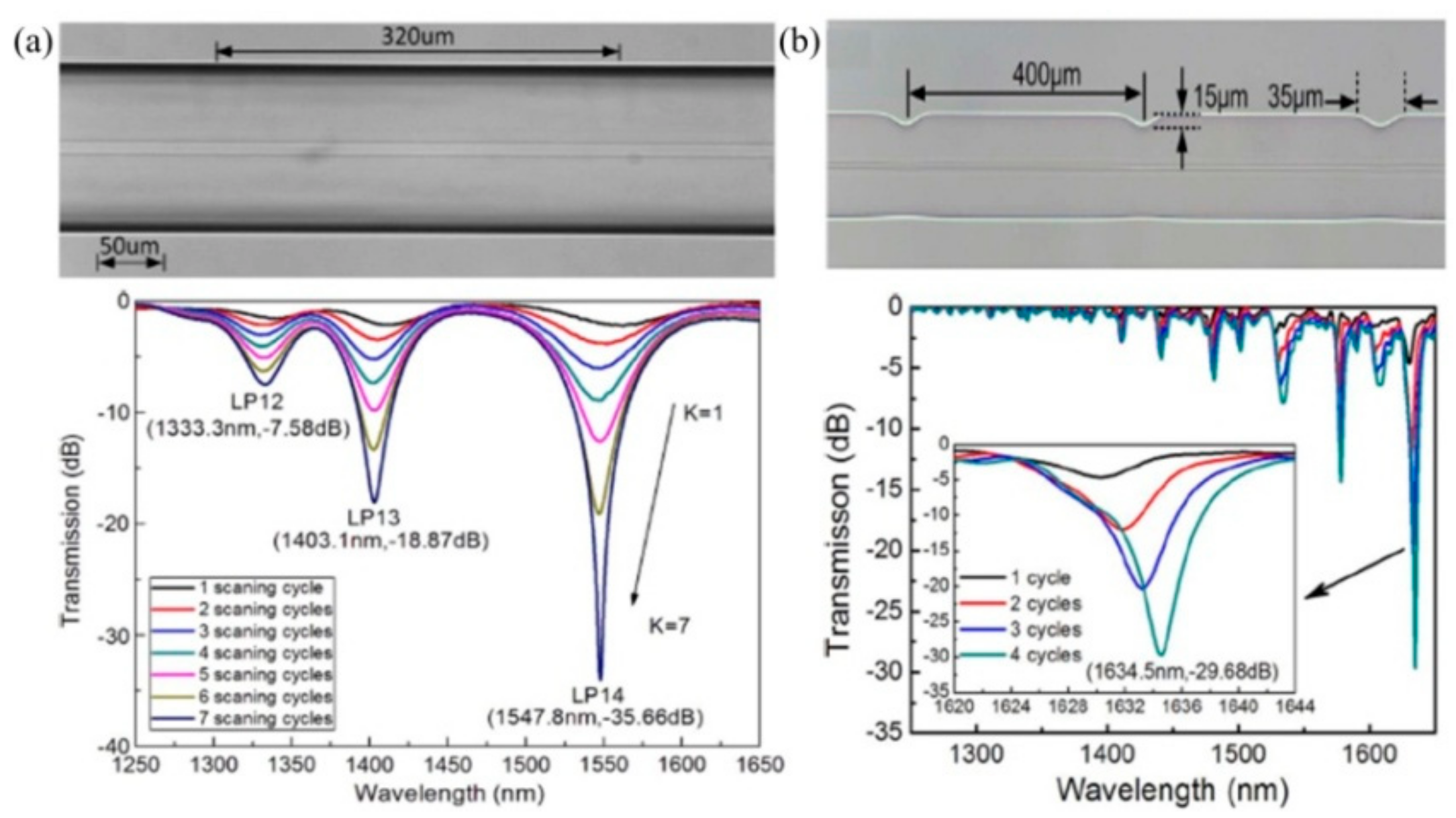
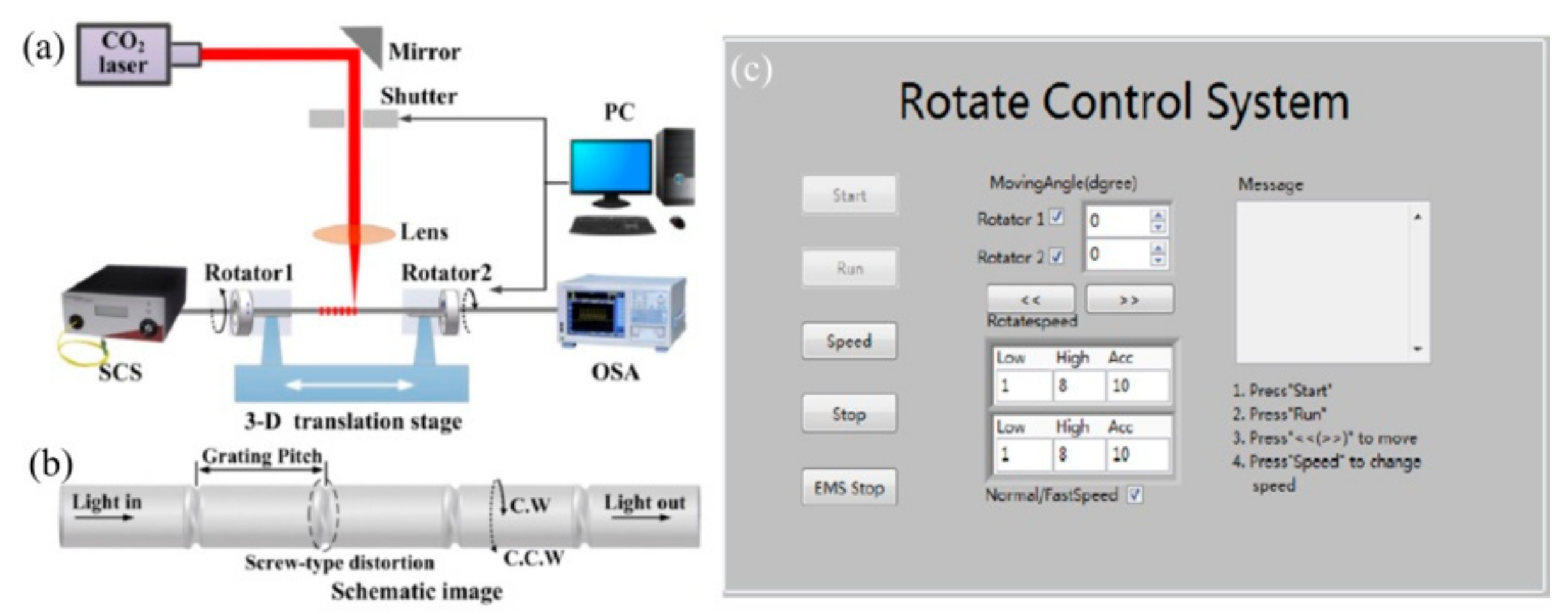
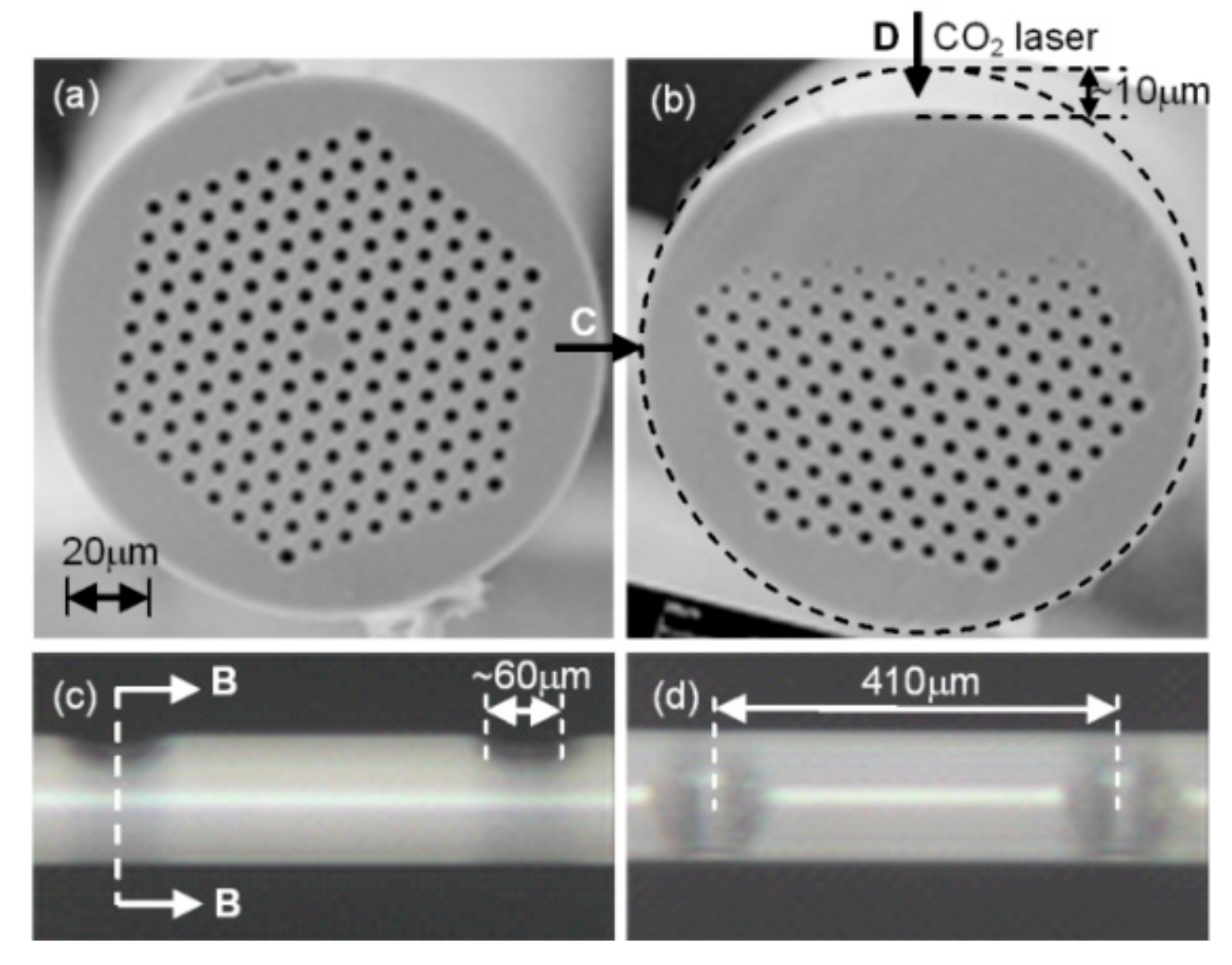



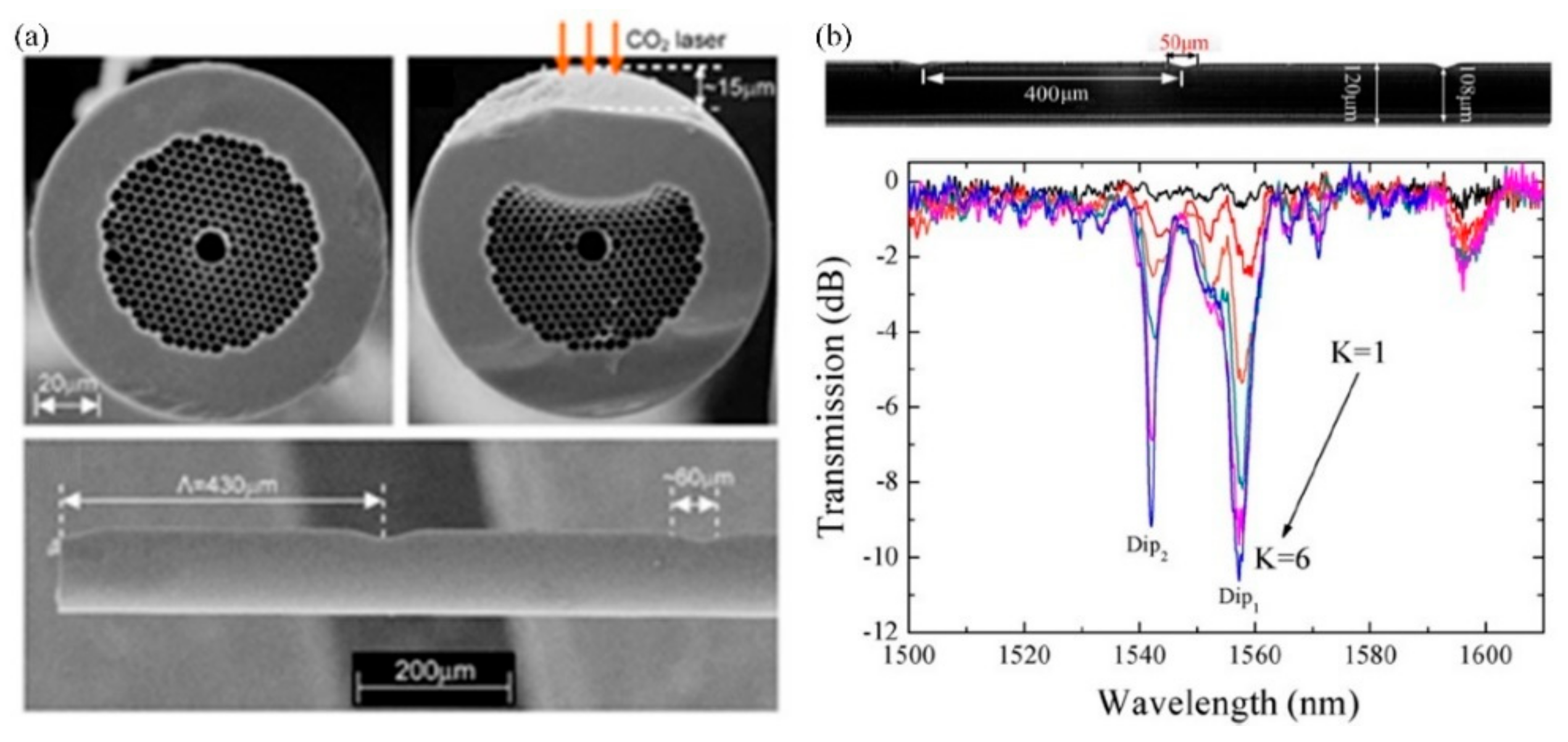

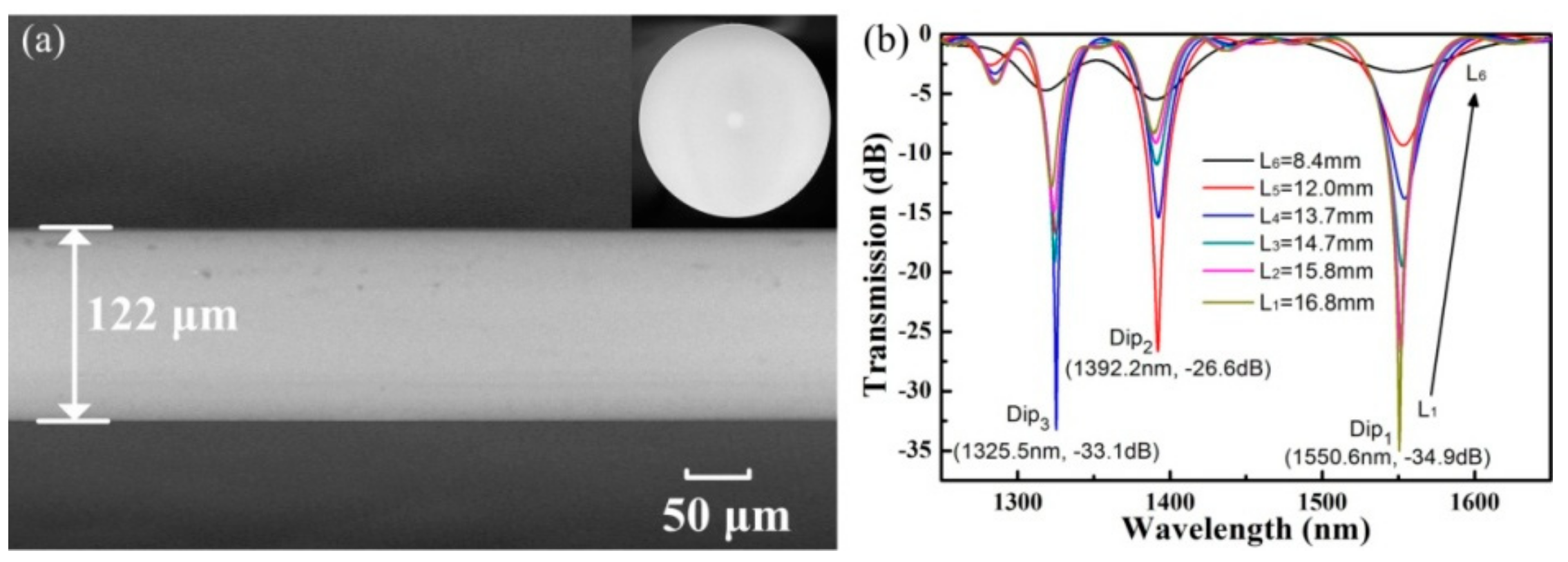
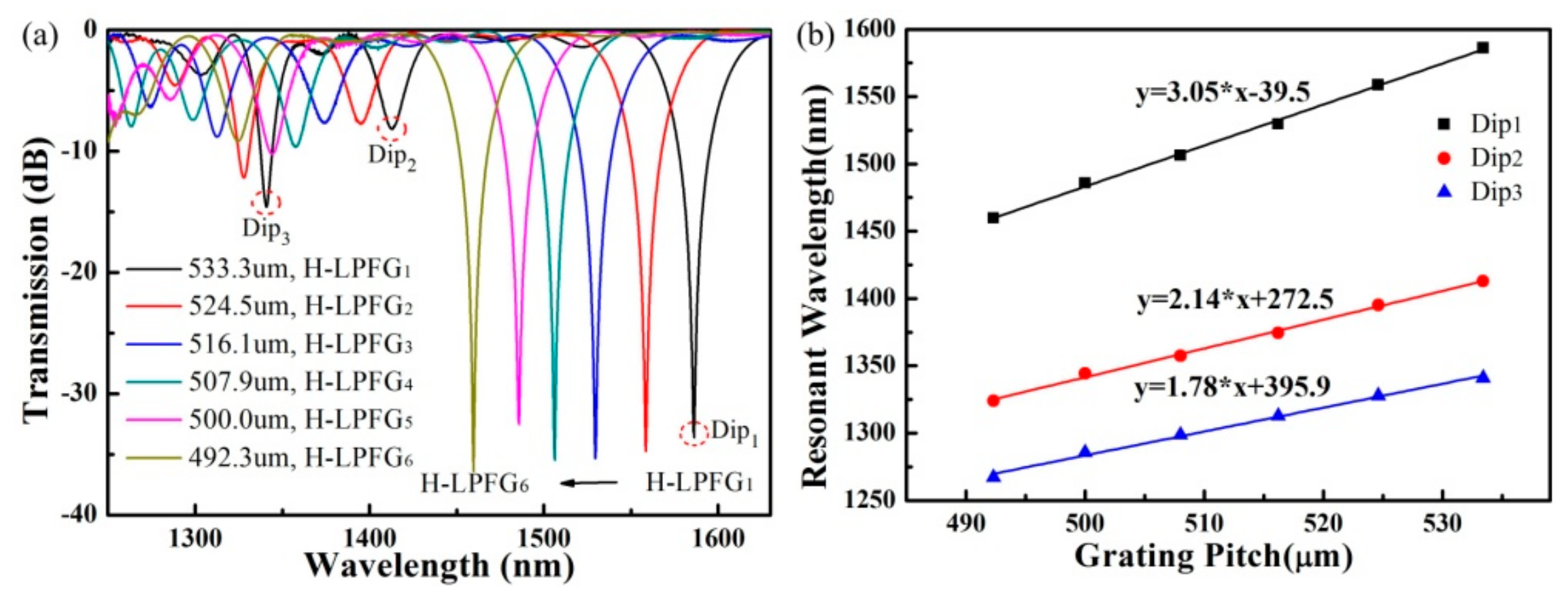
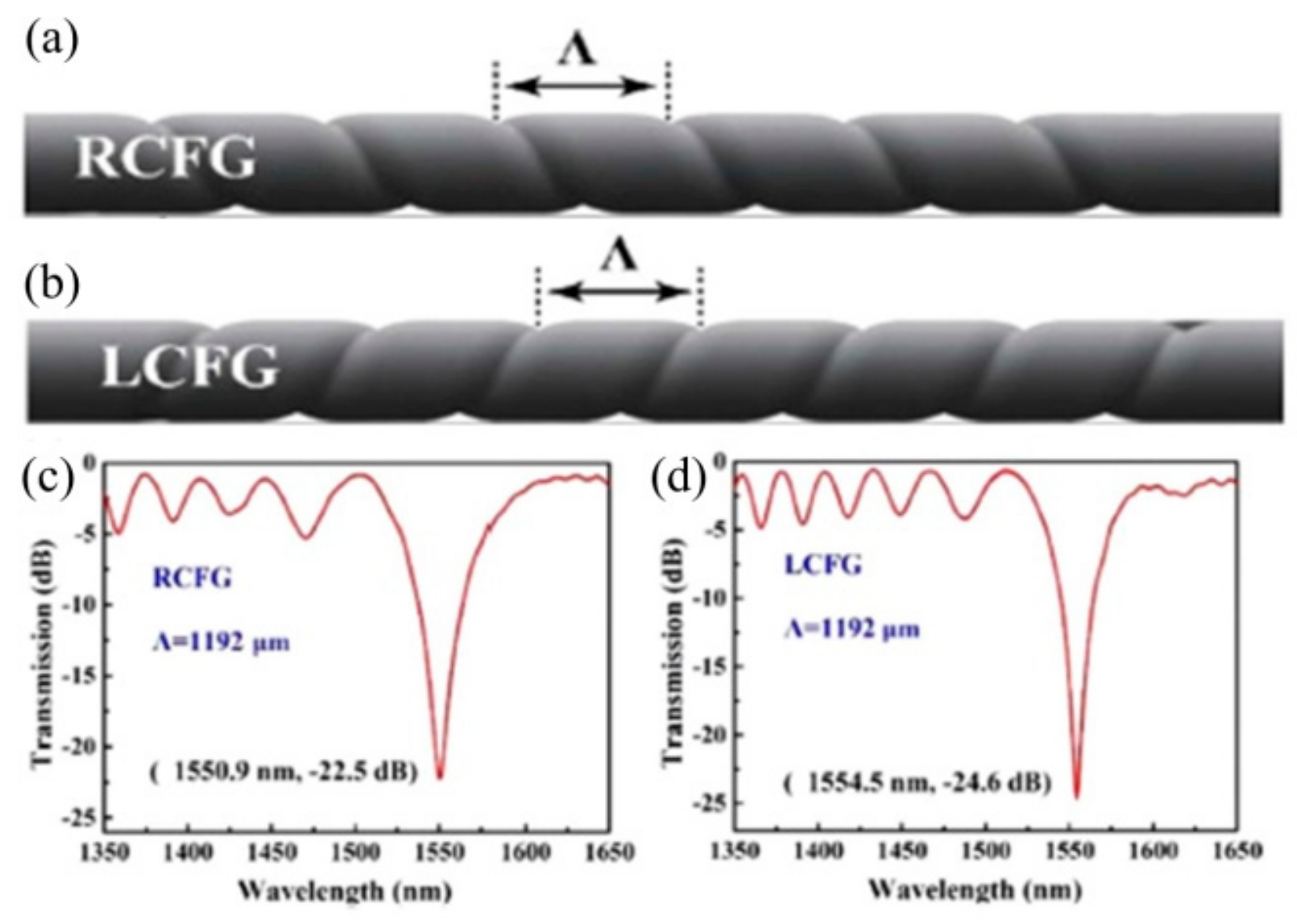
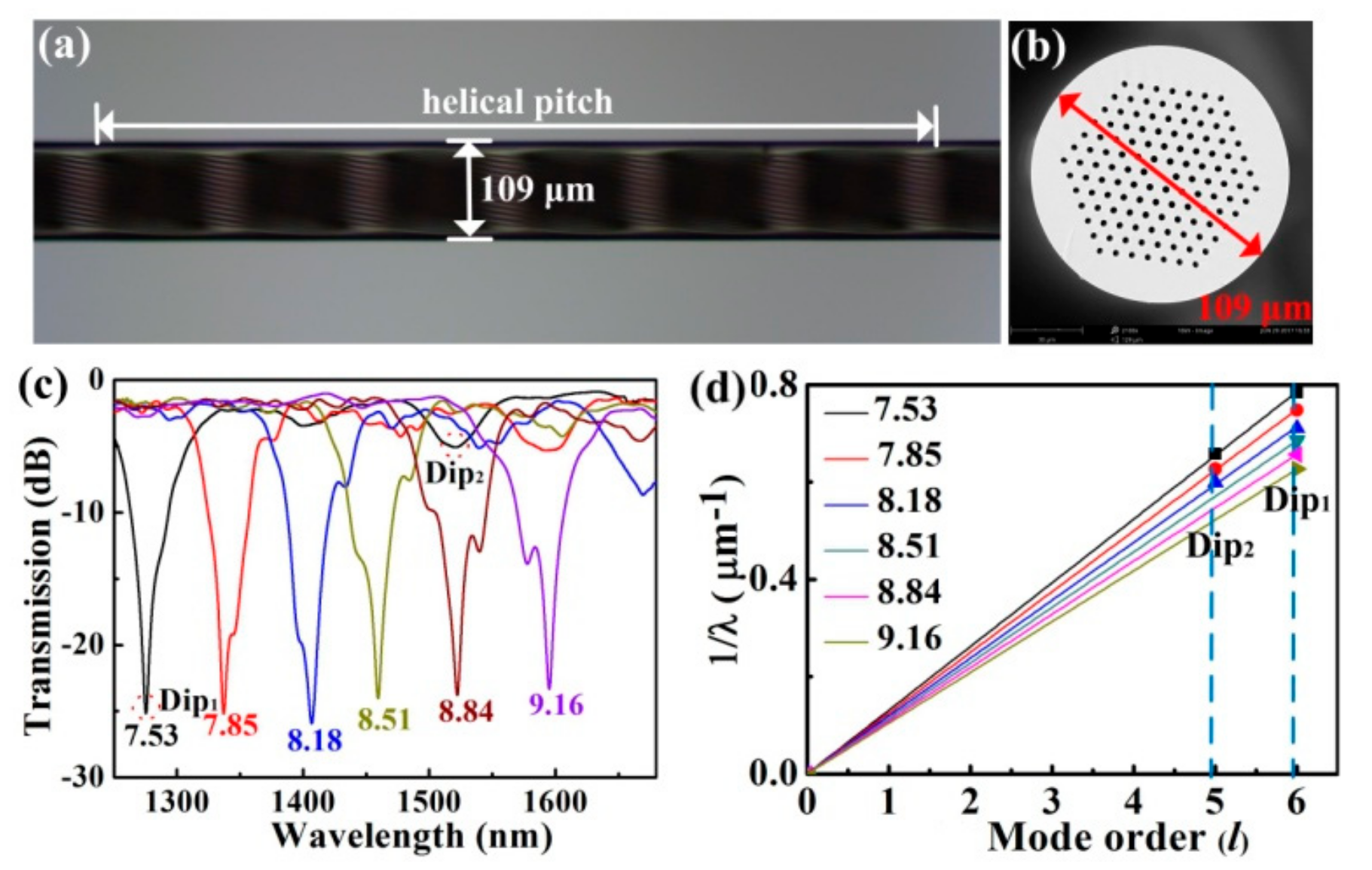









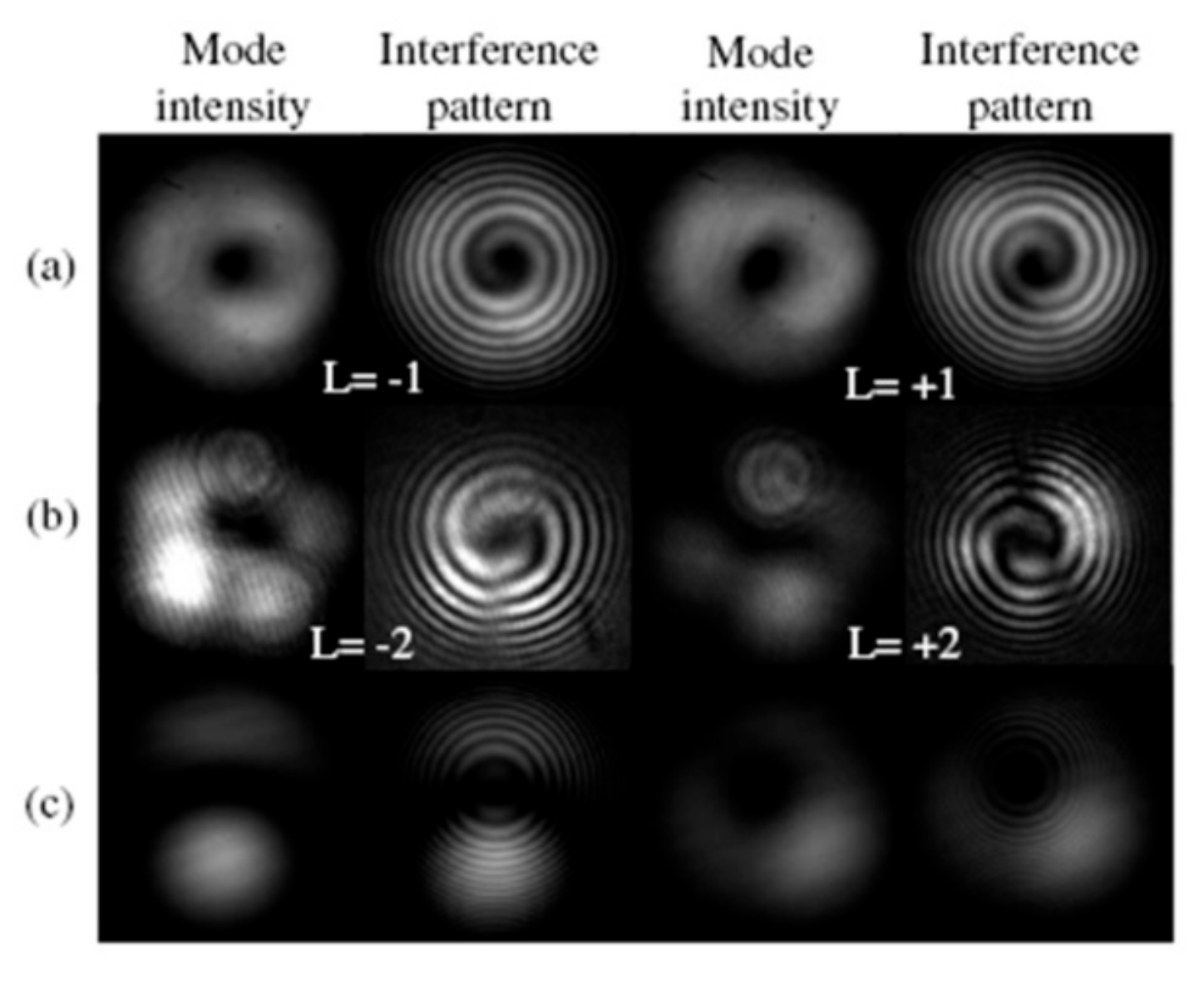
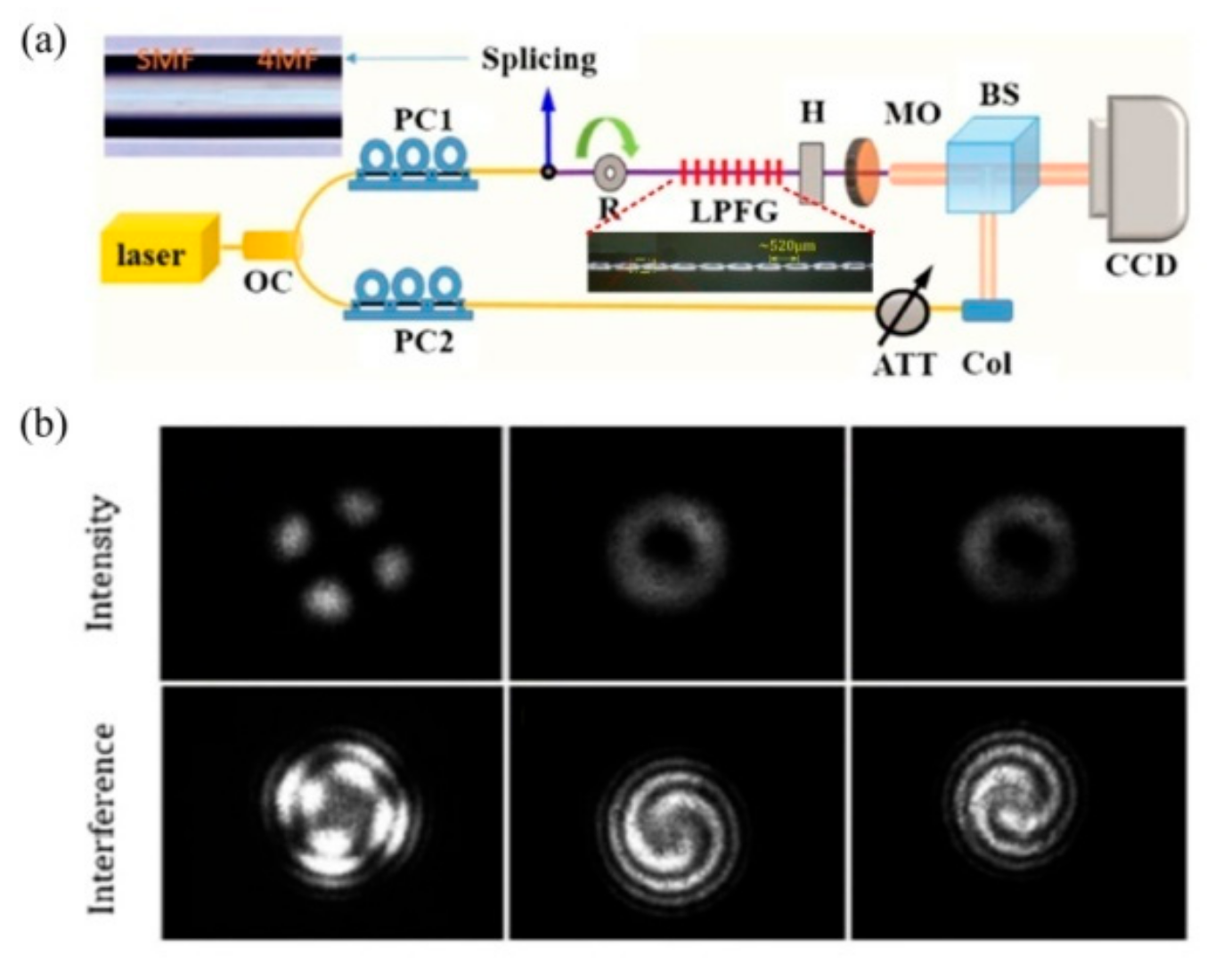

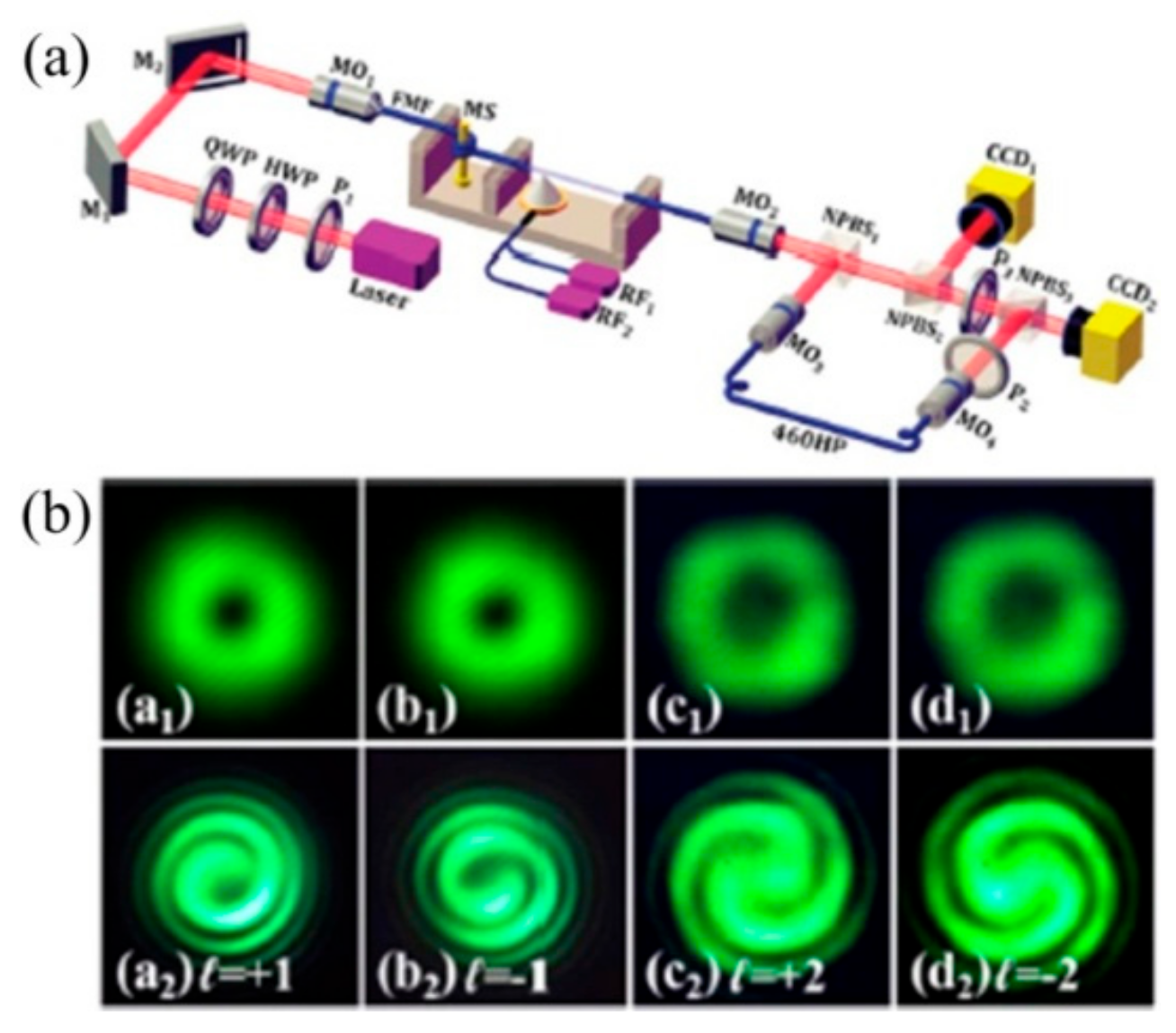
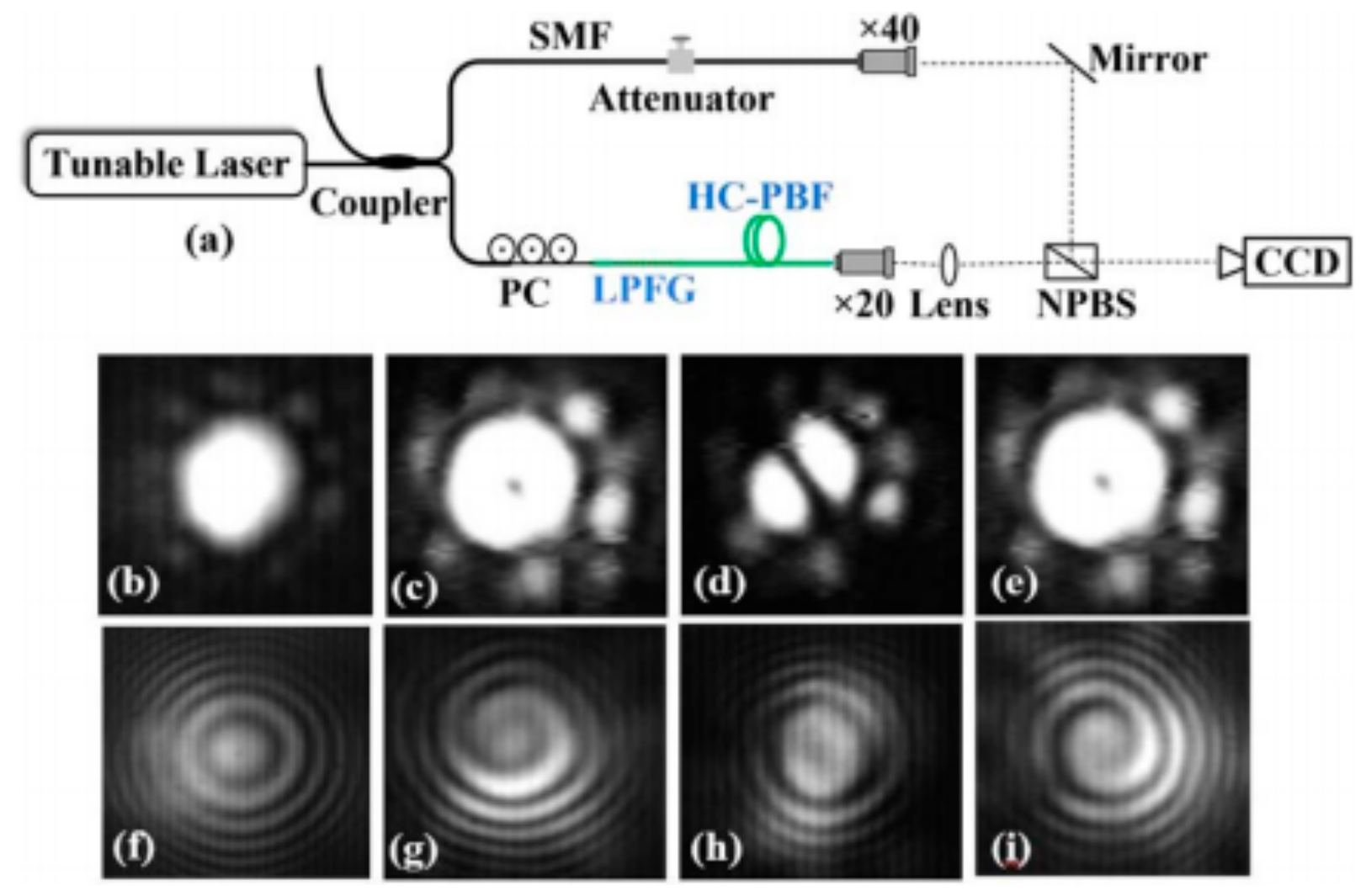


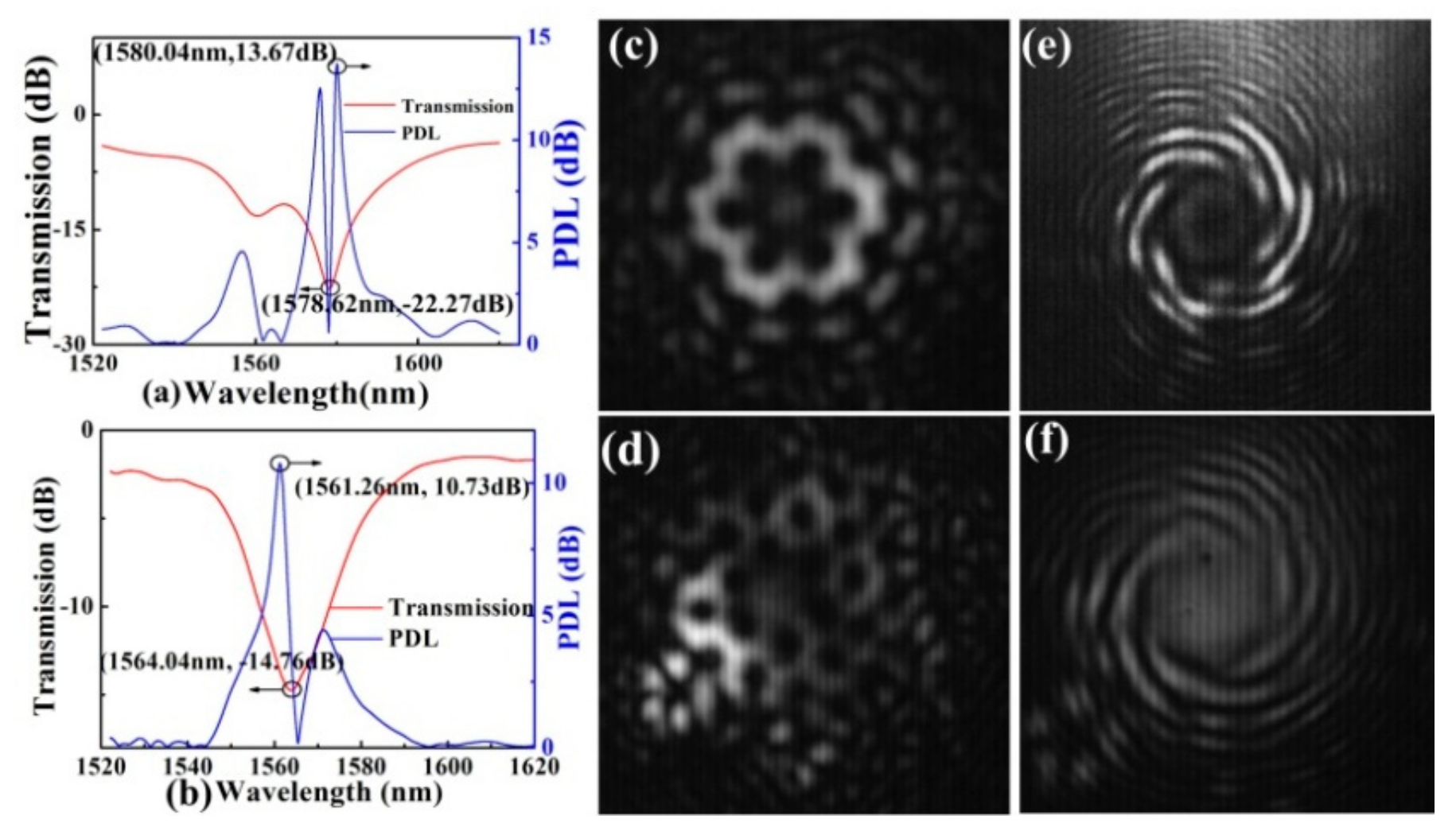
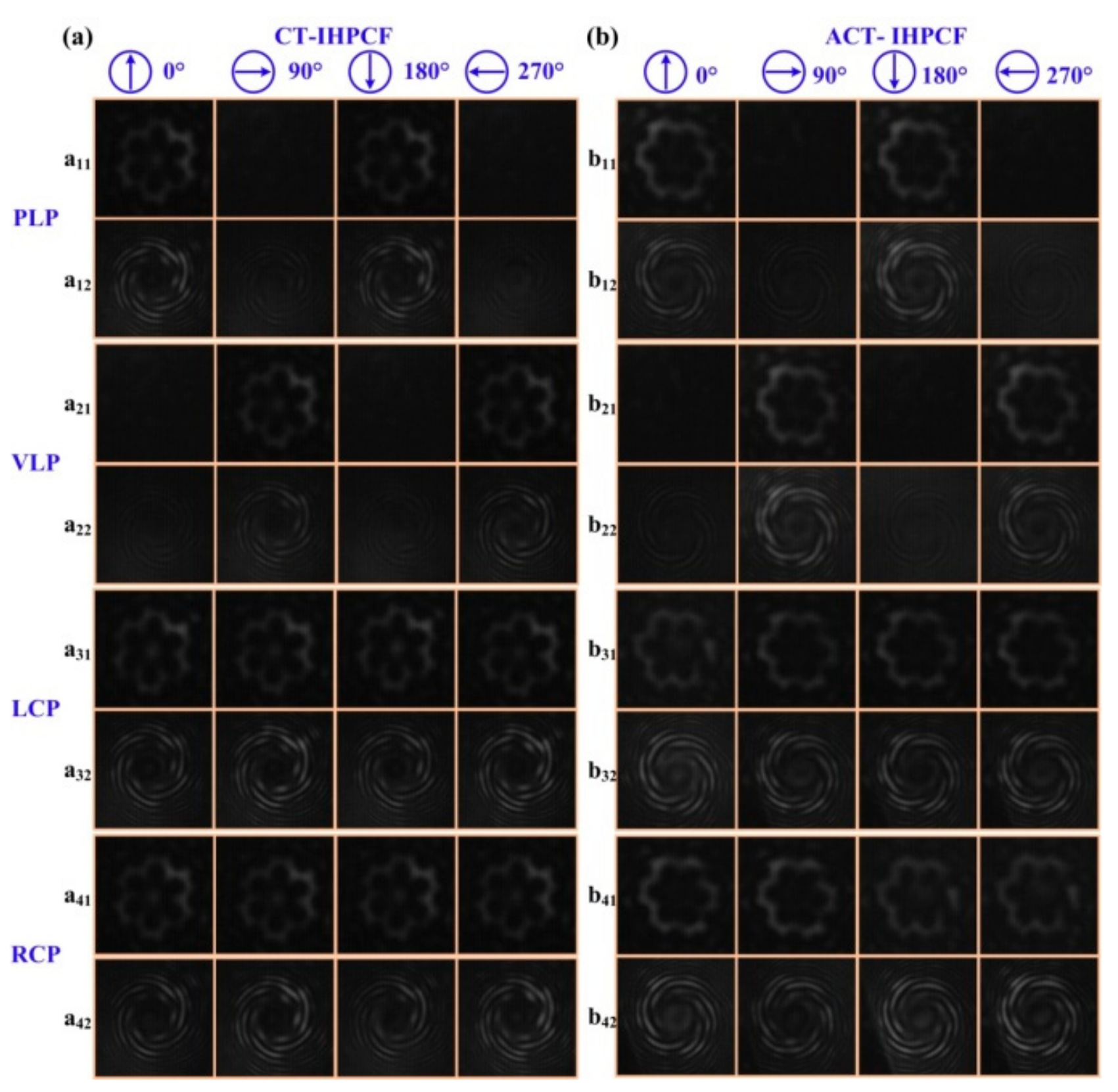

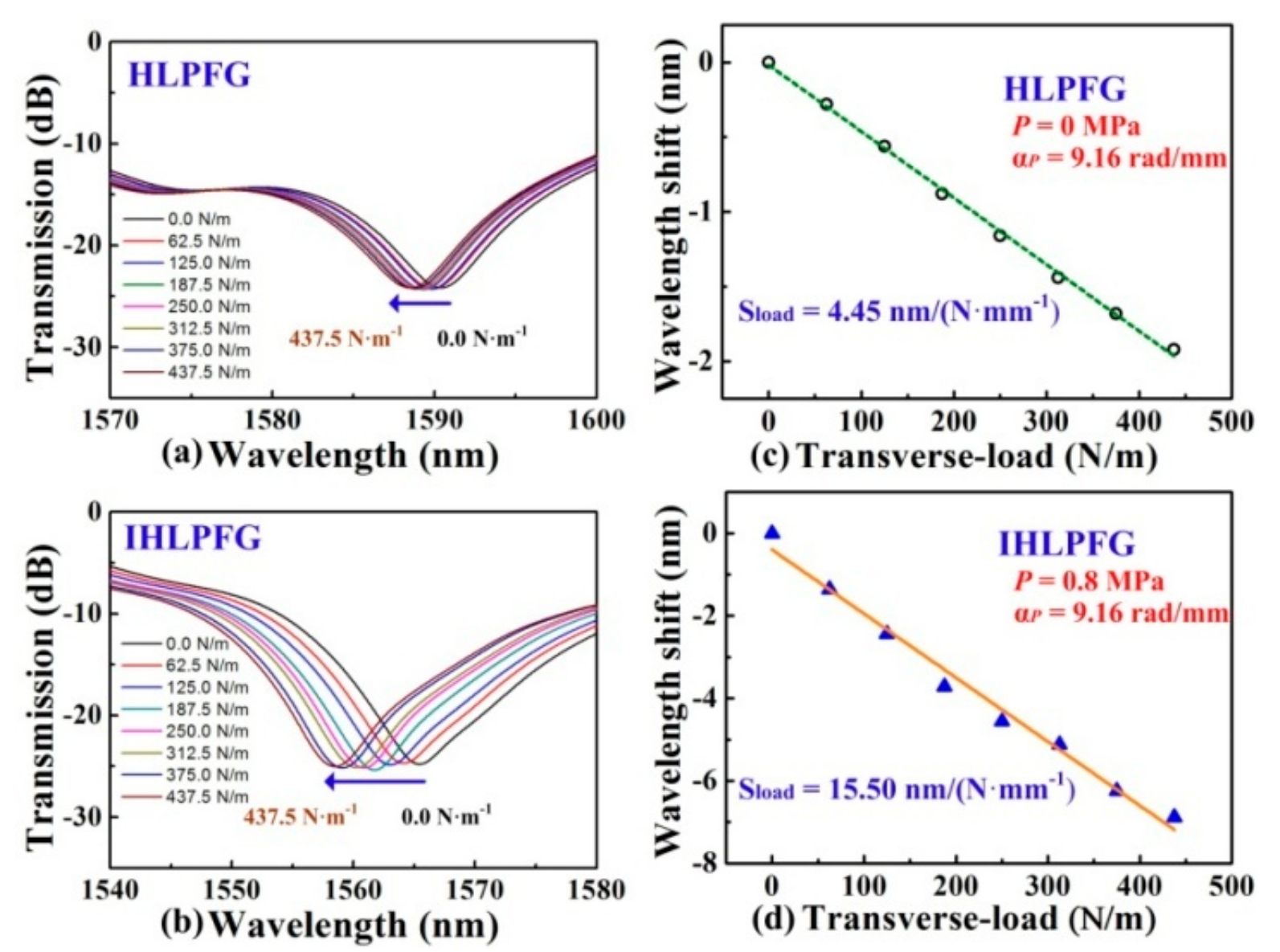



© 2019 by the authors. Licensee MDPI, Basel, Switzerland. This article is an open access article distributed under the terms and conditions of the Creative Commons Attribution (CC BY) license (http://creativecommons.org/licenses/by/4.0/).
Share and Cite
Fu, C.; Wang, Y.; Liu, S.; Bai, Z.; Liao, C.; He, J.; Wang, Y. Recent Progress in Fabrications and Applications of Heating-Induced Long Period Fiber Gratings. Sensors 2019, 19, 4473. https://doi.org/10.3390/s19204473
Fu C, Wang Y, Liu S, Bai Z, Liao C, He J, Wang Y. Recent Progress in Fabrications and Applications of Heating-Induced Long Period Fiber Gratings. Sensors. 2019; 19(20):4473. https://doi.org/10.3390/s19204473
Chicago/Turabian StyleFu, Cailing, Yiping Wang, Shen Liu, Zhiyong Bai, Changrui Liao, Jun He, and Ying Wang. 2019. "Recent Progress in Fabrications and Applications of Heating-Induced Long Period Fiber Gratings" Sensors 19, no. 20: 4473. https://doi.org/10.3390/s19204473
APA StyleFu, C., Wang, Y., Liu, S., Bai, Z., Liao, C., He, J., & Wang, Y. (2019). Recent Progress in Fabrications and Applications of Heating-Induced Long Period Fiber Gratings. Sensors, 19(20), 4473. https://doi.org/10.3390/s19204473







